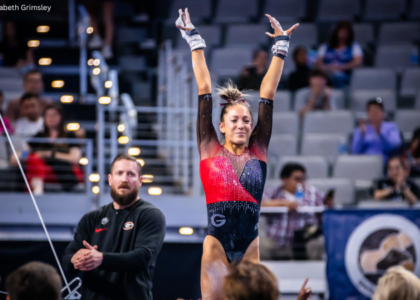College gymnastics has a reputation for being the place where athletes’ skills go to, not to die exactly, but to be simplified and polished. Difficulty becomes less valuable and execution is at a premium.
But for some gymnasts, simplifying and polishing isn’t enough. Whether because of their own goals as an athlete or their team’s goals for the season, there are gymnats who will develop new skills in college, or add to existing ones.
A prime example is the Yurchenko one and a half. It’s been 16 years since Nastia Liukin won the Olympic all-around title with a Yurchenko one and a half. One year after that, in 2009, the Yurchenko one and a half was devalued in the elite code, and more gymnasts returned to the simpler Yurchenko full as an alternative because the risk stopped being worth it. Case in point: only eight gymnasts competed the Yurchenko one and half at the Tokyo Games.
But in the post-Nastia era, it has become a popular vault in college. In the NCAA code, the Yurchenko full was devalued in 2015 to a 9.95 start value, while the Yurchenko one and a half retained its 10.0. In 2016, the first competition season after the code change, the one and a halfs performed at nationals received, on average, .06 more than the fulls, amounting to more than the start value difference. Since 2016, four of the six teams who have won national championships have done so with the highest vault rotation score. Oklahoma’s last two championships in 2022 and 2023 were won with a full lineup of 10.0 start-value vaults. Michigan, in kind, won their championship in 2021 with six 10.0 starts on vault.
It’s not easy by any means – that blind landing! – and not everyone, or even every team, is willing to risk it. CGN analyzed the vault in 2020, noting that a gymnast must be both powerful and have great technique to be successful with the Yurchenko one and a half upgrade.
Adrian Burde, who coaches vault at Florida, said he thinks the Yurchenko one and a half is a risky enough upgrade that the Yurchenko full should be further downgraded, to a 9.9. “It’s not that hard to teach a full and land it safely,” Burde said. “[But] going from a full to a one and a half, you take a lot of risk.”
Knee injuries, including ACL tears and hyperextensions, are common injuries with the upgrade, Burde said. Utah’s Grace McCallum hyperextended her knee after upgrading to a one and a half last year, for example. Florida’s own Victoria Nguyen had a scary fall on one of her attempts last season.
But one thing is true: if you want to win, your vault lineup should have more 10.0 starts than not. UCLA’s Janelle McDonald believes that the Bruin vault lineup in 2023, which was mostly comprised of Yurchenko fulls, is what kept them from making the final four at nationals. “Our team was really diligent about, ‘How do we get better [on vault] this year?'” McDonald said.
And for gymnasts who have competed either the Yurchenko full or Yurchenko double in elite or Level 10 competition, developing a one-and-a-half is usually the simplest step towards increasing that start value.
“I always start with the landing,” Burde said. At Florida, most recruits are elites, who rarely train the Yurchenko one and a half. Level 10 gymnasts are more likely to train it because they know it will make them more attractive recruits, he said, so schools who recruit primarily Level 10s are more likely to start off a season with usable one and a halfs.
McDonald says that of the current crop of NCAA gymnasts, those who came through elite in the last five years likely did not train the one and a half. But, she said, she is seeing more elites who are training it now. “The [Yurchenko] double is a really hard vault” in terms of the power needed to generate the rotation, she said. Few NCAA athletes keep their doubles in college competition. “The one and a half is a little more sustainable if you can get the technique of it,” she said.
The landing, Burde said, is “the biggest problem” for gymnasts upgrading to a one and a half. First, he said, he makes sure the gymnast has the air awareness to land the vault safely. “I try to go backwards,” he said, because “to me, safety is a very, very important thing.” He drills the landing repeatedly, moving from the trampoline and tumble track to the pit, with the athletes landing on mats of varying sizes. To train the gymnast to spot her landing, Burde has her lie on a spotting block and practice dropping one arm down while keeping an eye on the ground. Finally, once he is confident in the gymnast’s ability to land the Yurchenko one and a half, he moves to training back one and a half twists from standing on the vault, doing handstand snap-downs, and working on the entry – finding where to punch the springboard, for example.
McDonald has her gymnasts work uphill timers so that they can perfect their form off the table. It is crucial to her that a gymnast perfect her position off the table before initiating the twist. “You have to be able to create the layout and not rush the twist,” McDonald said. Air awareness comes into play for the landing. “If your technique is really dialed in, if you’re a really technically sound gymnast, you can do fairly well even if vault is maybe not the easiest event for you,” she said.
McDonald notes that one of UCLA’s most powerful vaulters, Chae Campbell, has continued to do a very consistent Yurchenko full during her college career. “She was the only All-American from the national championship last year who did a full,” McDonald said. She said in a case like that, she will opt for consistency over the extra half-tenth in start value.
For most gymnasts, Burde said, it will take a summer or a full preseason to make the upgrade. Kayla DiCello, who deferred this season at Florida to make a run at the Olympics, is an exception; she picked up the upgrade before her freshman season last year. “She learned it very quickly,” Burde said.
Auburn’s Olivia Hollingsworth made the switch to a Yurchenko one and a half this season, after competing a Yurchenko full in her first three years on the team. She is averaging a 9.816 with it so far this season, whereas she averaged 9.813 in 2023 with her full, according to Road to Nationals. Because national finals often come down to thousandths of a point, the value of her upgrade is there. Hollingsworth said that she has had weak ankles throughout her career, and has not always been able to make her numbers. She added that she has always been one to choose consistency over risking injury, but said that with age came a confidence boost in her abilities. “It’s been fun training new skills,” she said. “It’s more motivation, more of a push in the gym.”
College gymnastics does not have to mean the end of skill development, Burde said. “Everything is teachable,” he said. “I really believe that.”
READ THIS NEXT: Judge’s Inquiry: Key Things to Look for in Popular NCAA Skills
Article by Lela Moore





7 comments